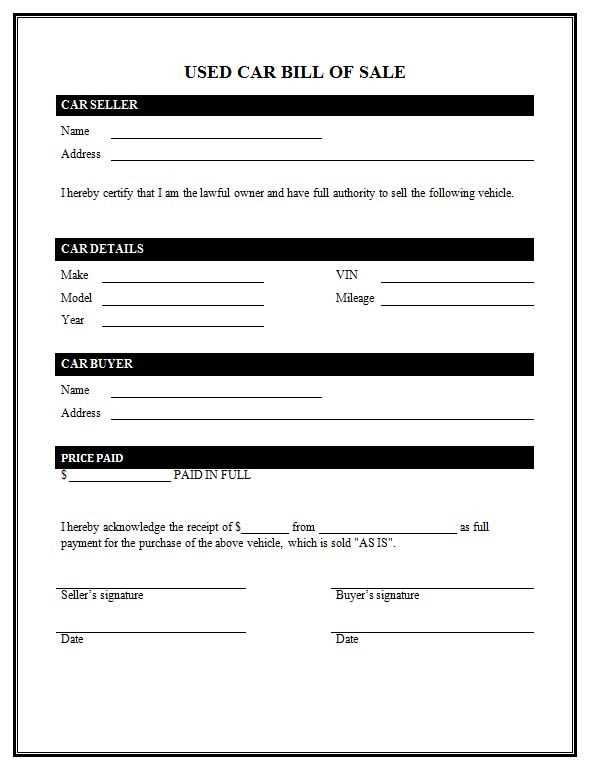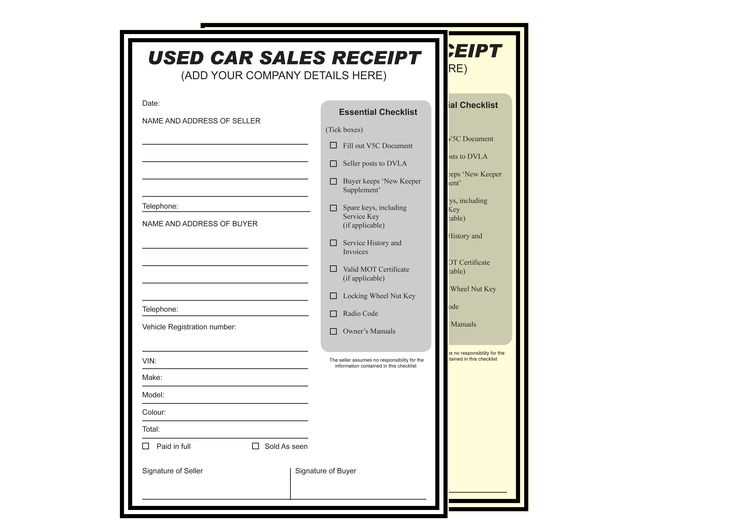
For a smooth car sale transaction, it’s important to have a detailed and clear receipt. This document serves as proof that the vehicle has been sold, outlining the terms and conditions agreed upon by both parties.
Start by including the date of the transaction and the full names and contact details of both the seller and the buyer. This ensures that both parties are identifiable in case of any future inquiries or disputes.
List the vehicle details such as make, model, year, Vehicle Identification Number (VIN), and mileage. Including these specifics provides clarity about what exactly is being sold, avoiding any potential confusion or misunderstanding.
It’s also important to specify the sale price and the method of payment, whether it’s cash, bank transfer, or another agreed-upon method. This ensures transparency and prevents any payment disputes after the sale.
Lastly, include a section that states the condition of the car at the time of sale, mentioning whether the vehicle is being sold “as is” or with any warranties. Both parties should acknowledge these terms, which can be signed to confirm mutual understanding and agreement.
Template Receipt for Sale of Car
To create a receipt for the sale of a car, include these critical details: the buyer’s and seller’s full names, addresses, and contact information. Clearly state the date of the transaction and the vehicle’s make, model, year, color, VIN (Vehicle Identification Number), and odometer reading at the time of sale.
Specify the sale price of the car and any additional terms or conditions agreed upon by both parties. If there are any warranties, indicate them in the receipt, or state “sold as-is” if no warranty is provided.
Example Template:
Receipt for Sale of Vehicle
Seller’s Name: John Doe
Buyer’s Name: Jane Smith
Vehicle Details:
- Make: Honda
- Model: Accord
- Year: 2015
- Color: Black
- VIN: 1HGBH41JXMN109186
- Odometer Reading: 75,000 miles
Sale Price: $10,000
Date of Sale: February 12, 2025
Condition: Sold as-is
Seller’s Signature: ______________________
Buyer’s Signature: ______________________
Preparing the Sale Agreement Details
Begin by clearly stating the full legal names of both the buyer and seller. Include the seller’s address and contact details. Specify the car’s make, model, year of manufacture, VIN (Vehicle Identification Number), and current odometer reading. This ensures both parties are on the same page regarding the vehicle in question.
Detail the sale price and the agreed method of payment–whether it’s a lump sum or installment plan. If applicable, mention any deposits already paid or payment terms. Outline any warranties, guarantees, or conditions tied to the sale, if relevant.
Ensure both parties agree on the transfer of ownership. Specify that the buyer will assume responsibility for the vehicle once payment is made and ownership is transferred. Include any specific terms about registration, taxes, and fees that each party will cover.
Clarify the sale as an “as-is” transaction, if that’s the case, making sure both the buyer and seller are aware of this condition. This can help avoid future disputes. If the car is being sold with a warranty, make sure the terms are clearly written out.
Finalize with both parties’ signatures and the date. Keep a copy for both the buyer and seller for reference and legal protection.
Signing the Receipt: Legal Considerations

Ensure both parties sign the receipt to confirm the sale transaction. This document serves as proof of the sale and protects both the buyer and seller in the event of disputes. Without signatures, the agreement might not hold legal weight.
Verify that the names of both parties are clearly stated and match the identification documents. This helps prevent future issues related to the ownership transfer. Include the vehicle’s registration number, make, model, year, and VIN to avoid confusion.
The date of the transaction should be included on the receipt. This is important for any warranty claims or legal matters that may arise after the sale.
- The receipt should indicate the agreed-upon purchase price.
- Ensure both buyer and seller retain a copy of the signed receipt.
- If applicable, include any warranties or conditions in writing.
Before signing, both parties should review the document for accuracy. Errors on the receipt can complicate the transfer of ownership or lead to misunderstandings. Double-check the terms and ensure both parties agree on them.
Keep in mind that signing the receipt does not transfer the title of the car. The title transfer should occur through your local motor vehicle office, and additional paperwork may be required for official registration.
Handling Payment and Transfer of Ownership

Secure the payment method before transferring ownership. Confirm the buyer’s payment through bank transfer, certified cheque, or other reliable methods. Never hand over the vehicle until the full payment is received and cleared in your account.
Prepare the necessary documents to finalize the transfer. These typically include a signed bill of sale, the car’s title, and any other required paperwork according to your local regulations. Ensure that both parties sign these documents to make the transaction official and legally binding.
Once payment is confirmed, transfer the car’s title to the buyer. This process may involve completing sections on the title document and notifying your local registration office to update the records. Some regions may require both parties to be present to finalize the change of ownership.
Provide the buyer with a receipt of the transaction that includes the sale date, amount, and vehicle details. Keep a copy for your records to protect yourself in case of any future disputes.


